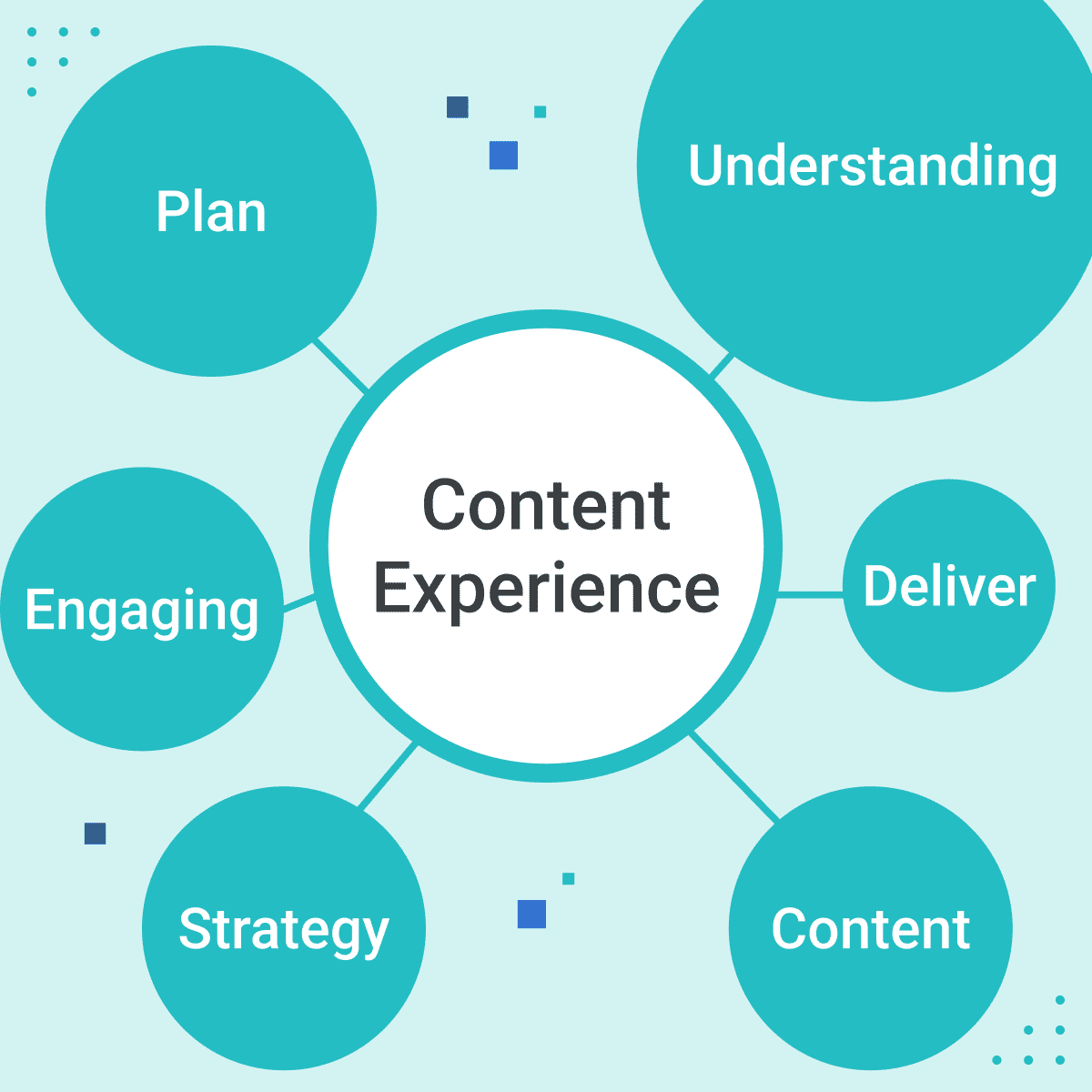This guest blog post was written by Leah Catania, a content strategist for TraceLink. She also has extensive experience with usability testing and building document designs. She received her MA in Professional Writing from the University of Massachusetts Dartmouth.
Content Experience: What is it and Why is it important?
In today's digital age, content is king. But it is not just about creating high-quality content; it is about crafting a holistic content experience that resonates with your audience and builds trust in your brand.
MadCap Software understands the importance of a seamless content experience, where every interaction—from design and organization to access and updates — works together to provide value to the user.
In this article, we will explore the intricacies of content experience, how it differs from content marketing and customer experience, and provide practical tips on building a content experience strategy that aligns with your company's values and meets the needs of your audience.
What is content experience?
Content experience encompasses every way that users interact with your content:
- Design
- Organization
- Location
- Access
- Update notifications
Your content experience also encompasses all your company produces, regardless of the audience, purpose, or which department is writing and distributing it.
This scope is why you need to think about your company’s content experience holistically. You never really know how users will interact with your content or which other content they’ll come from or jump to. Thinking holistically keeps the experience consistent, which helps orient users, affirm the company’s brand, and build trust that regardless of which resource users are reading or looking at, the company knows what they’re talking about. A holistic approach also ensures users can trust that all the content is coming from the same place, moving in the same direction, and different resources won’t contradict each other.

How is content experience different from content marketing and customer experience?
Content experience often gets thrown around like a buzzword. How is it different from others you have heard, like content marketing, customer experience, or user experience?
These concepts are interrelated, so let’s look at it from the top down.
First, you have customer experience (also known as CX), which includes every interaction that customers have with your company and your products, both before and after purchase. This includes everything from reading marketing material and talking to a salesperson to using the product and reading the documentation or taking a training course to email or call support. All these actions make up the customer’s holistic experience, and their experience with your content is just a piece of that.
User experience (often referred to as UX) is similar to content experience — pretty much adjacent in this little hierarchy we’re building here. Part of your content experience is specifically the UX of your content.
What does it look like?
What interactions does it include?
But UX also applies to the company’s products themselves: what they look like, their information architecture and user flows, and their interaction patterns.
And then there is content marketing, which sounds so much like content experience that many resources you might come across talk about experience like it only or primarily applies to marketing content or commerce websites when it’s so much more than that. Content marketing itself needs to be a part of the journey you take your audience through, just like all the other content types your company has. It’s usually high-quality content that engages users on its own because the information it contains is useful for your target audience, regardless of whether they choose to use your products or not.
Content marketing can be longer-form and come in any variety of mediums. Companies use this type of content to build trust with the company’s brand without trying to market more directly about their products. Once people trust the brand, they’re more open to learning more about the products. It serves an important purpose, but it’s just one piece of the holistic content experience, just like your technical documentation and training courses are.
So, to summarize each of these:
- Customer experience encompasses all interactions with people, products, and content.
- User experience encompasses interactions with products and content.
- Content experience encompasses interactions with all types of content.
- Content marketing is one type of content that users interact with.
How do you build a content experience strategy?
If content experience is a new concept for you, you might be wondering how to create a content experience strategy, especially one that deals holistically with all the company’s content. Even if this concept is not new, you might still feel at a loss and not sure where to start.

Start small
I always find that with an overwhelming project in front of me, concentrating on the absolute basics first makes it easier to get started, so let’s begin there. You already have some of these in place.
First, focus on just your team. I come from a technical writing background and have always worked on technical writing or communications teams, so my guidance here is focused on starting a content experience strategy as a technical writer, but all of the concepts can easily be adapted to other teams, like marketing or training.
As a team, do you have a style guide? If so, great! Your team’s content should already be consistent, assuming you’re all diligent about following it. Does your style guide address things beyond the writing styles and formatting you use? When you are concentrating on content experience, you also need to make sure you have guidelines for information architecture (IA). Each piece of content should be organized as similarly as possible, even if they are several types of documentation. This allows users to familiarize themselves with the repeatable patterns, which builds familiarity and trust.
If your team only has a single product, keeping the IA consistent is straightforward. However, when you deal with multiple products, beyond making sure each guide is as consistent as possible, you also need to think about how your different guides are related. Usually, there’s some commonality since most companies don’t create multiple products that work completely in a vacuum. You need to define a consistent way for your writers to link between them and decide how the different documents will be organized as a group.
Do you create an overall knowledge base that links out to each guide? Or are they only accessible separately, through the product or individual URLs? Or do you need several knowledge bases? If so, how are they organized, and how can they be consistent?
Your team also probably already has a publishing strategy in place that defines where and how you publish, the frequency of your updates, and how users get notified. However, you still need to evaluate this as well. Is the publishing strategy consistent or different for every product or document? If each product has a different publishing strategy, is that helpful for your users? What benefits are the different strategies bringing to the users or the writers? Or are they just adding to the overall frustration on both sides because writers can’t remember what to do or users can’t find the content they need in the moment when they’re already confused?
Expand the strategy
Once you have a clear, defined content experience strategy implemented within your team, you can turn your attention to the content other teams produce. If you are at a small company, you might already be actively coordinating with marketing writers, UX writers, trainers, or instructional designers, but this is usually a lot harder the bigger the company gets.
Do you have multiple tech writing teams? Get them together first before reaching out cross-functionally beyond the writers. Once all the technical writers are integrated into the content experience strategy and producing consistent content, you can begin reaching out cross-functionally.
What types of content does each team produce? Is there an overlap? Or, worse, duplication? When different teams work in silos, they often end up creating the same content in similar ways. A common example of this is when support teams write procedures for commonly asked support questions because they don’t realize those procedures are already documented somewhere else. This is a waste of time and effort for the writers but also confusing for users. Find places where you can consolidate the content and reduce that duplication.

Is everyone using the same style guide? Probably not, and sometimes that is for good reason when you are writing several types of content or working in different mediums. But you should still do an audit of the various style guides each team owns. Catalog all their similarities and differences. Go through the similarities until they are as identical as possible. Evaluate each difference to determine if it is different for a good reason. Do the differences bring specific value that is worth being inconsistent?
Next, look at the relationship between all the different content types. Does your technical documentation link to your training videos and courses for similar content? Do the content marketing articles link to the technical documentation for further explanation of the details or a look into how your company’s product helps them with that function? If you are already doing this, wonderful! Do all the different cross-functional teams have processes in place for coordinating when they have content about related subjects so you can continue bringing them together?
It’s not easy, but it is worth it
A truly holistic experience strategy requires a huge amount of cross-functional collaboration and coordination with all teams producing content. For this collaboration to work, everyone involved needs to buy into the idea of building a holistic experience, which then helps put aside any ego or friction about whose content is more important or whose styles should take precedence.
It is not easy, and it takes real dedication. Building a strategy across the entire company usually succeeds best when it’s spearheaded by 1 or 2 people with a clear vision who either already have or can develop strong relationships with the other content teams. Whether these leaders come from the technical writers, marketing writers, or instructional designers isn’t important—what matters most is that they understand, inside and out, the different types of content that every team produces, the audience and purpose for each content type, and the nuances between them that need to be maintained for the content to continue to be useful for its intended audience.
In Conclusion
Creating a cohesive, holistic content experience ecosystem across your entire company elevates your content in a world where users are constantly saturated with information. It helps users trust your brand and leaves them feeling confident in the information they have taken away, whether that’s general industry information from content marketing or how-to information from documentation.
MadCap Central is the ideal content management platform to help you achieve the cohesive, holistic content ecosystem described in this article. By leveraging the power of MadCap Central, you can streamline your content creation, organization, and distribution processes, ensuring that your audience receives consistent, high-quality information that builds trust in your brand. With its user-friendly interface and robust features, MadCap Central empowers your content teams to collaborate effectively, creating a seamless content experience that resonates with your audience and sets your company apart in today's information-saturated world.









